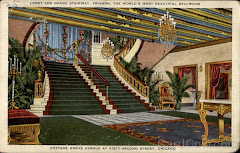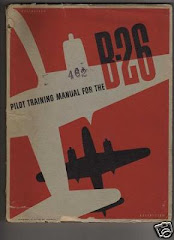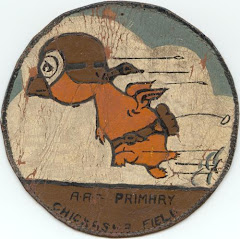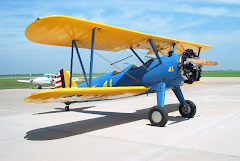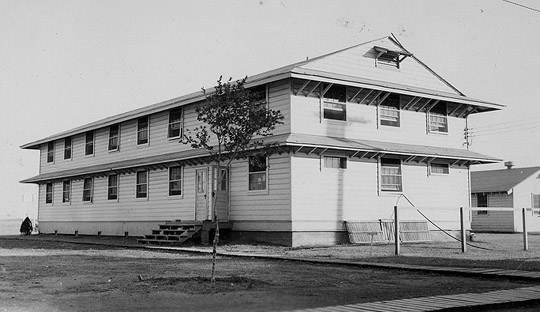Finally in late May of ’42 it was time to graduate and get those coveted Silver Wings.
The graduation was held in the base theater at ten in the morning. My folks and my oldest sister came down from Nebraska and my oldest brother, the one that I’d worked for on the ranch, and his wife came. My other brother and his family, that ones that I’d lived with when I was working on the cotton inspection team, had been transferred to a small community in southern Illinois where he was managing a pipeline station. The closest large town to them was Terre Haute, Indiana. Later, that had a big part to play in my life.
Our Graduation was as impressive as any ceremony I’ve ever attended since. The pomp and circumstance started and ended with marching of course. It’s hard to explain the thrill of being in uniform and marching in cadence while singing an inspiring song like the Army Air Corp anthem or the National anthem. It made your chest swell up with pride. I couldn’t carry a tune but luckily I was drowned out by a corps that could, and I felt like million as I sang at full volume and strode into the hall. We took an oath to our country and listened to a couple of speeches which congratulated us on surviving the most demanding training course in the military. The Brigadier General told us that so far over 40% of the cadets who entered flight training had washed out before graduating.
Next came the moment we anticipated, the presentation of the Silver Wings by the Lieutenant Colonel R. C. McBride. At the same time, we were promoted to 2nd Lieutenant, received our gold bars and a big dose of pride and excitement. In addition to the wings and the bars we also got a packet of “calling cards” with our name and rank: Lieutenant Air Corps, which we promptly exchanged with the other guys in our class and gave to our families. There was another benefit that we (and our families) appreciated and that was our new pay scale. We were now going to make $1,800 a year, plus we were entitled to a 50% bonus for flight pay!
It was a tradition when you received your Silver Wings that the first person that had to salute you, had to give you a dollar! That was a lot of money in 1942 when a bottle of cola was 5 cents and the daily newspaper cost 3 cents. Usually it was one of the lower classmen. I was so excited I have no memory of who had to give me my dollar.
Showing posts with label WWII. Show all posts
Showing posts with label WWII. Show all posts
Saturday, July 31, 2010
Sunday, February 22, 2009
Chapter 11 Primary Flight Training Continues
In Chickasha we received our training at a civilian owned and operated flight school, The Wilson and Bonfils Flight School. Classes were also taught and flight checks given by a military staff.
Close order drill, calisthenics and obstacle courses continued in Primary school as did the classes in airplane recognition, meteorology, and ground school. The Army method of learning was memorization. We were expected to be able to memorize everything. It was a good discipline and in times of stress, it stood you well.
Our accommodations at W&B were known as the “Country Club” because everything was civilian in the mess hall from food to dishes and in the barracks from the beds and mattresses to the linens. Everything outside the mess hall and the barracks was strictly military.
In the afternoons our flight training continued. I was lucky to have done my solo a little earlier than most of the cadets. I was able to spend more time shooting landings and practicing the basics and acrobatics. When he rode with me after my solo, the instructor taught me forced landings. He’d cut the throttle and force me to find a place to land. Luckily there were a lot of fields in Oklahoma. Just about the time the wheels were going to touch the ground, he would take over and climb to a safe altitude, then hand it back and tell me to practice something else. Soon he’d cut the throttle again and I’d be forced to land again. Later, I spent a lot of time practicing these forced landings myself. Little did I know all that practice would eventually save my life and the life of 6 other crew members somewhere over France.
There were flight checks at the end of each phase of flying lessons. There was nothing the “checkers” liked better than washing out the unfit pilots. If you didn’t make the grade, or even if they just didn’t like you, you could be weeded out. You got two chances. If you didn’t pass the first test you got one more by a different checker. He knew it was your second of course, and if you failed his check you were reassigned to navigator or bombardier school. Luckily, I never had to take a second flight check.
Winter in Oklahoma was pretty cold and many days we woke to snow deep enough to entertain us guys by making snowmen or blow off some steam by having a few snowball fights. Mostly we had 10 short weeks to learn how to fly and between that and military drills and classes there wasn’t a lot of free time.
When our ten weeks was up Class 43E had a Graduation ceremony. Those that made it through were sent on to Basic Flight Training. Our class was going to Enid Army Flying School in Enid, Oklahoma
Close order drill, calisthenics and obstacle courses continued in Primary school as did the classes in airplane recognition, meteorology, and ground school. The Army method of learning was memorization. We were expected to be able to memorize everything. It was a good discipline and in times of stress, it stood you well.
Our accommodations at W&B were known as the “Country Club” because everything was civilian in the mess hall from food to dishes and in the barracks from the beds and mattresses to the linens. Everything outside the mess hall and the barracks was strictly military.
In the afternoons our flight training continued. I was lucky to have done my solo a little earlier than most of the cadets. I was able to spend more time shooting landings and practicing the basics and acrobatics. When he rode with me after my solo, the instructor taught me forced landings. He’d cut the throttle and force me to find a place to land. Luckily there were a lot of fields in Oklahoma. Just about the time the wheels were going to touch the ground, he would take over and climb to a safe altitude, then hand it back and tell me to practice something else. Soon he’d cut the throttle again and I’d be forced to land again. Later, I spent a lot of time practicing these forced landings myself. Little did I know all that practice would eventually save my life and the life of 6 other crew members somewhere over France.
There were flight checks at the end of each phase of flying lessons. There was nothing the “checkers” liked better than washing out the unfit pilots. If you didn’t make the grade, or even if they just didn’t like you, you could be weeded out. You got two chances. If you didn’t pass the first test you got one more by a different checker. He knew it was your second of course, and if you failed his check you were reassigned to navigator or bombardier school. Luckily, I never had to take a second flight check.
Winter in Oklahoma was pretty cold and many days we woke to snow deep enough to entertain us guys by making snowmen or blow off some steam by having a few snowball fights. Mostly we had 10 short weeks to learn how to fly and between that and military drills and classes there wasn’t a lot of free time.
When our ten weeks was up Class 43E had a Graduation ceremony. Those that made it through were sent on to Basic Flight Training. Our class was going to Enid Army Flying School in Enid, Oklahoma
Subscribe to:
Posts (Atom)




